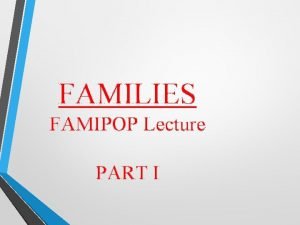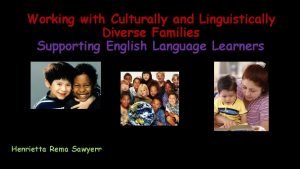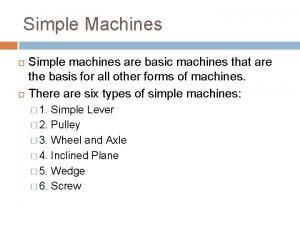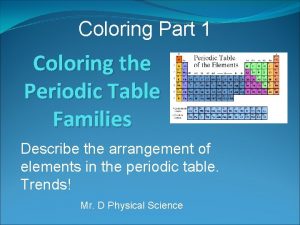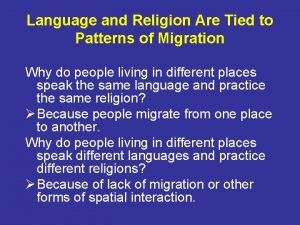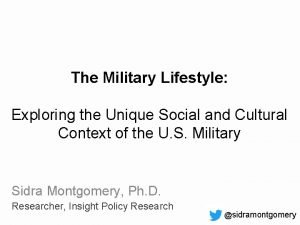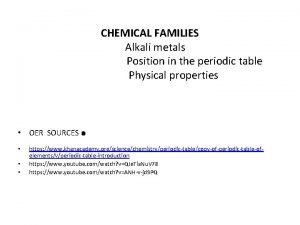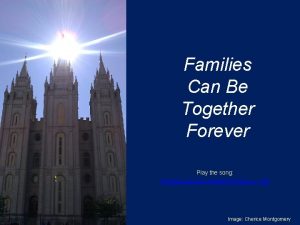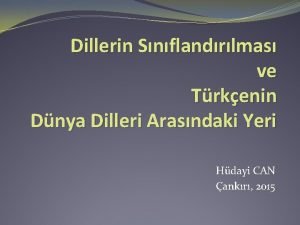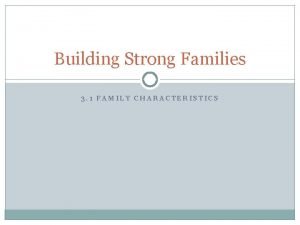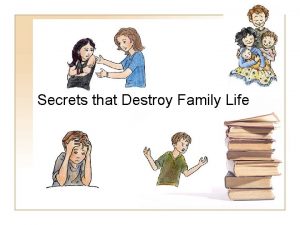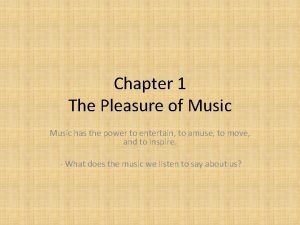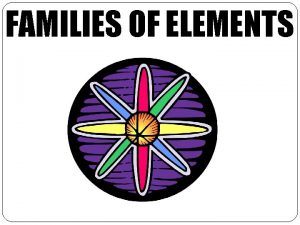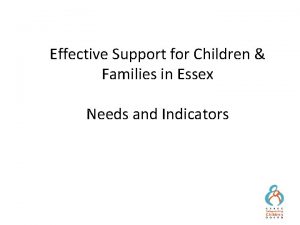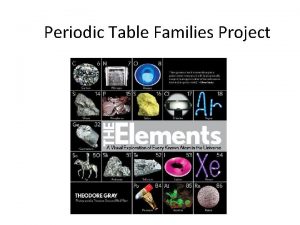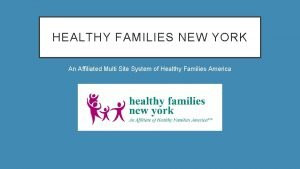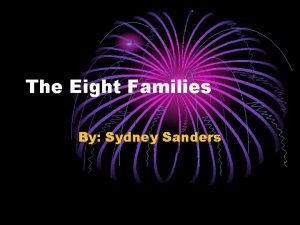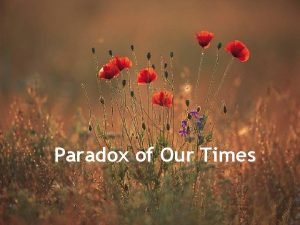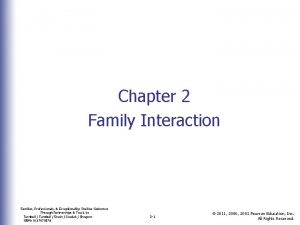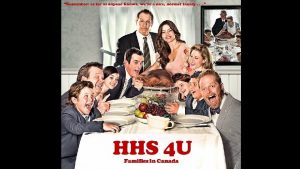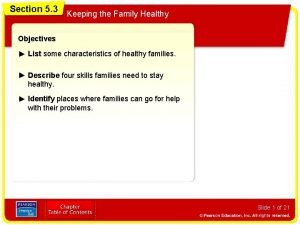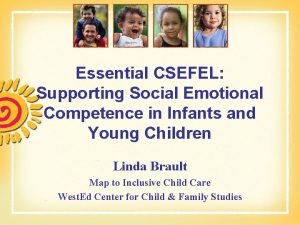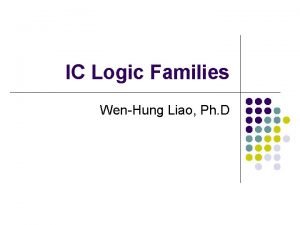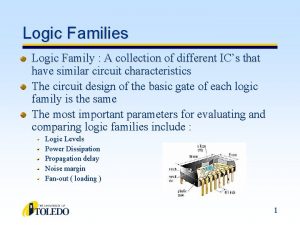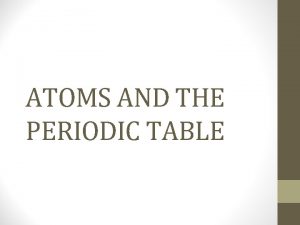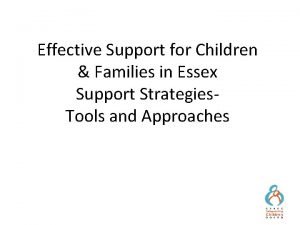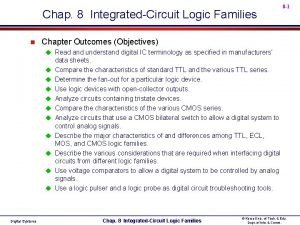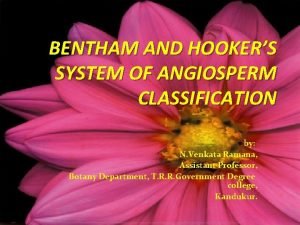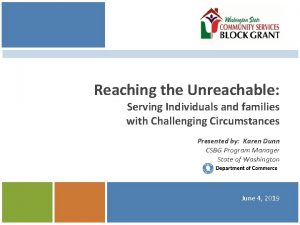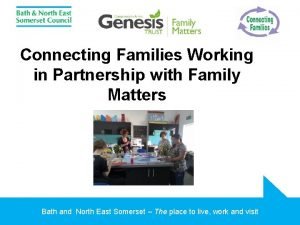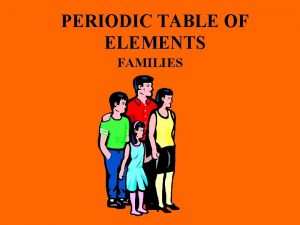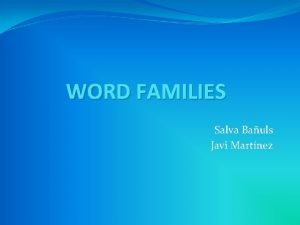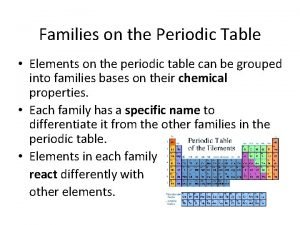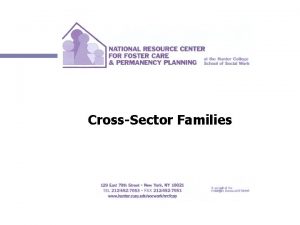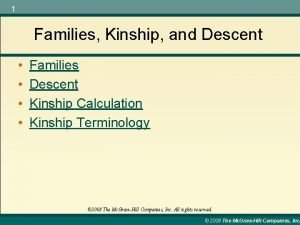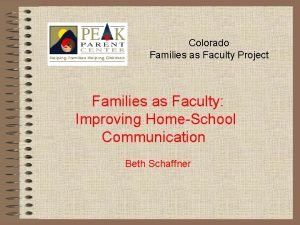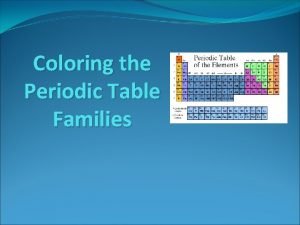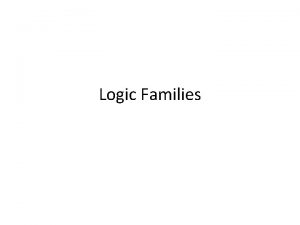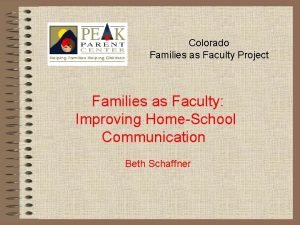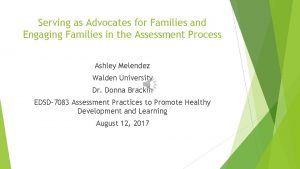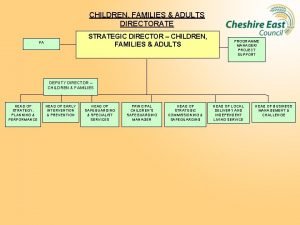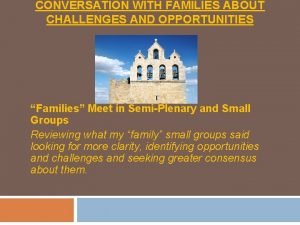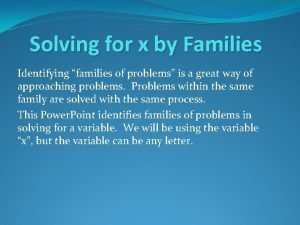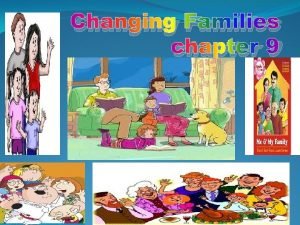FAMILIES FAMIPOP Lecture PART I PART 1 1





























































- Slides: 61

FAMILIES FAMIPOP Lecture PART I

PART 1 1. Classic definition of family 2. Family structure and composition 3. Functions of family 4. Four traditional elements of family formation 5. Complexities of defining family

The third group symbolized family through the façade of a house, 1⁄2 which is bahay-kubo like, and 1⁄2 which is hollow-blocked, cemented. The use of a house provide a sense of “home, ” a sense which remains, continues to grow, whether the house be bahay-kubo like or cemented, modernized. The sense of “home” accommodates a lot, if not all, the concepts linked with being a family, such as the reciprocal support between members, the sense of identity made possible, the love and commitment involved in being family, etc.

FAMILY *A cultural and social construction. The meaning of the family is relative depending on the cultural context of the person being asked. Social Construction Theory is concerned with the ways we think about and use categories to structure our experience and analysis of the world. (Jackson, Penrose)

Family could vary in terms: 1. Size 2. Membership (who are members of the family) 3. Values and Beliefs 4. Formation 5. Type (marriage types) Family variation can be manifested through different cultural aspects like architecture, rituals, practices, material objects, and other behavioral manifestations.

FAMILY • A social institution. • Institution is a s_____l st____ture or mechanism that creates s____l or____ and co_______n. (examples? ) • *Has undergone multiple transformations historically, but has remained intact.

FAMILY’S CLASSIC DEFINITION “A social group characterized by common residence, economic cooperation, and reproduction.

FAMILY’S CLASSIC DEFINITION • It includes adults of both sexes, at least two of whom maintain a socially approved sexual relationship, and one or more children, owned or adopted, of the sexually cohabiting adults. ” (Murdock, 1949 in Medina, 2001: 12 -13)

• How about this culture in which cohabiting couples do not live together or do not even consider marriage. • Mosuo (pronounced as Mósuō) People • “Walking Marriages” (Mutual Affection)

How does that work? • The man usually asks the permission of the woman for a home visit. • Visits are usually kept secret and are done after dark. • Man spends the night with the woman and returns to his home in the morning. • Man can have as many sexual partners as desired. • Couples do not share property and man does not have responsibility with his offspring.

Types of Family Nuclear Extended

Structure and composition: Nuclear family *Based on consanguineous (genetic; kinship) and affinal relations (through marriage) *Myth: NF as isolated and detached from other kin

Structure and composition: Extended family *Nuclear family + anyone who does not belong to the nuclear (at least three generations).

Structure and composition: Extended family *Three interlocking nuclear families: family of origin, family of procreation, and family of affinal relations.

Functions of family

Functions of family *Regulate sexual access and activity

Current Representations A Secret Affair No Other Woman The Legal Wife The Mistress

Functions of family • *Provide an orderly context for procreation. • Birth Spacing • Number of children

Functions of family • Nurture and socialize children (values, knowledge, skills, etc. ) • Ensure economic stability • Provide security and emotional support

ELEMENTS OF FAMILY FORMATION 1. Mate selection 2. Marriage 3. Residence 4. Sexual intercourse 5. Children

Mate Choice or Mate Selection • Free Choice of Spouse • Free Choice with Parental Approval • Arranged Marriages

Family formation: Mate selection • Bride Price • Love • Attraction • Other reasons

Family formation: Mate selection 1. Who to marry Endogamy vs. Exogamy Homogamy vs. Heterogamy Hypergamy vs. Hypogamy

Family formation: Mate selection • How many to marry (monogamy vs. polygamy) Polyandry

Example Nyinba people of Nepal (Fraternal Polyandry)

Family formation: Mate selection Polygyny

Family formation: Mate selection • Attraction may vary depending on one’s cultural standard • Eyes, ears • Nawa of Africa value elongated labia majora

Family formation: Mate selection • Love

That thing called ‘LOVE’ Love—strong emotional attachment with sex desire and tenderness. ‘Romantic love complex’ in relationships (i. e. , falling in love as a highly desirable basis of courtship and It must have been love but it's over now. It must have been good but I lost it somehow. It must have been love but it's over now. From the moment we touched, 'til the time had run out. Make-believing we're together that I'm sheltered by your heart. But in and outside I've turned to water like a teardrop in your palm. And it's a hard winters day, I dream away. It must have been love but it's over now. It's all that I wanted, now I'm living without. It must have been love but it's over now, it's where the water flows, it's where the wind blows.

Caveat: 1. Love is not necessarily the foundation of marriage. 2. Marriage or intimate relationship is not always like lying in the bed of roses. 3. Marriage is not a always like a fairy tale or a Romeo and Juliet Story as described in the song I CAN LOVE YOU LIKE THAT.

Courtship and Mate Selection █ The Love Relationship – Coupling of love and marriage not universal Many world cultures give priority to factors other than romantic feelings

Other forms • Sister Exchange Marriage- Among the Turkic and the Yanomamo. • Levirate- if a woman’s husband dies, she should marry one of her husband’s brothers, brother-in-law marriage. • Sororate- if a man’s wife dies, he should marry one of his wife’s sister, sister-in-law marriage.

Reasons for marriage • Attraction • Companionship • Social Pressure • Economic

Other Factors • Race • Age • Religion • Propinquity

Review Marriage involving one wife and several husbands: P__________ Marriage involving one husband several wives: P__________ A type of marriage in which the brother of a deceased man is obliged to marry his brother's widow: L_____ Marriage A type of marriage in which the sister of a deceased woman is obligated to marry her sister’s widower: S______ Marriage This usually involves the simultaneous marriage of a brother-sister pair from two households: Si______ Ex____ Marriage Traditional definition of family: A s____l g____p characterized by c______n r_____ce, e_____ic co_______n, and r______on. Hypergamy Vs. Hypogamy Endogamy Vs. Exogamy

Families can vary across societies • Insert Macionis, page 465


Finding a mate • School • Church • Bars (Show Video Clipping of Amnesia Girl)

Finding a mate • Dating Website • Family and Friends • Work • Social Gatherings • Others

Dating and Courtship • Getting to know each other. But there is a danger, it can lead to sexual advances. • See Video (Life as we know it)

The Proposal When the relationship grows and matures, there comes the proposal. Traditional (Harana or serenade and render labor ) Modern

Preparation Before Wedding • Pamanhikan or the wedding entreat is a ritual or an activity in which the groom asks the permission from the bride’s parents to get married. • In Korea, they have what they call the hahm which is a festival before the wedding day. • Others would call it MEET THE PARENTS (insert video)

Family formation: Marriage ceremony 1. When June Bride? The Lucky 8 and other interesting number combinations (12 -12 -2012, 11 -12 -2013, 12 -08 -2012) Other superstitious belief

Family formation: Marriage ceremony 2. How Traditional Modern

Importance of Marriage Ceremony • The wedding vow is the most important element in a marriage ceremony. • It is a spiritual covenant. • It symbolizes the intimate sharing of two lives (pagisang dibdib). • Omae hyaku made washa kujuku made, tomo in shiraga no haeru made- "Till you're one hundred and I'm ninety-nine, together till our hair grows white"

Family formation: Marriage ceremony 3. Who should be invited 4. How much 5. Who’s going to foot the bill —a potential source of conjugal conflict

Family formation: Marriage ceremony Guidelines for couples planning their wedding (Around and Pauker, 1987) 1. Plan 1 year in advance 2. Try to consider the feelings of other family members 3. Consider what is important to you and what your budget is. 4. Use the preparation as a time to share and make decisions as a couple 5. Try to keep it simple so you can enjoy it.

Family formation: Moving in/residence 1. Patrilocal 2. Matrilocal 3. Bilocal 4. Neo-local

Family formation: Having sex together *First night (two become one) *Honeymoon

Family formation: Having sex together • (US DATA) Married couples have sex about six to seven times per month (approx. at least twice per week) as compared to cohabiting couples an singles. • Couples should agree when to have it, how many times (in a day, a month, or a week), and how to go about it. Some individuals may find their partners too scandalous. • Positive sexual relationship in terms of quantity and quality is an indication of a happy married life. • Married people supposedly should have satisfying sexual relationship.

Family formation: Having sex together Top Five Sexual Issues for Married Couples *Dissatisfied with amount of affection from partner *Difficulty keeping sexual relationship interesting *Sexual relationship not satisfying (related to sexual health issues like ED, PE, anorgasmia or the inability to have an orgasm ) *Dissatisfied with level of openness in discussing sexual topics *Reluctant to be affectionate because partner may interpret it as a sexual advance Source: Olson and Olson, 2000

Family formation: Having sex together There also different sexual techniques 1. In some societies, one partner will inflict pain on the other partner during love making. 2. Apineyean (Apinaye) women of South America have been known to bite off bits of their partner’s eyebrows. 3. Trukese (Chuukese) women in the South Pacific (Micronesia) poke fingers in the man’s ear when sexually excited.

Types of sexual dysfunction • Sexual interactions can be frustrating but in most cases a source of happiness and joy. • Problems • • • Premature ejaculation (man reaches orgasm quickly than woman) Retarded ejaculation Ejaculatory incompetence (unable to ejaculate in partner’s vagina despite firm erection and high level of arousal) Rapid orgasm in women Painful intercourse

Family formation: Having a child within a year *The socially expected first born (China Case) *Timing *How many children (family planning methods—cost, safety and efficacy) *Sex ratio in the family

REVISITING THE FAMILY’S CLASSIC DEFINITION “A social group characterized by common residence (? ), economic cooperation (? ), and reproduction (? ). It includes adults of both sexes (? ), at least two of whom maintain a socially approved sexual relationship (? ), and one or more children (? ), owned or adopted, of the sexually cohabiting adults. ” (Murdock, 1949 in Medina, 2001: 12 -13)

Alternative definition: Two or more persons who share resources and responsibility for decisions, values and goals, and have a commitment to each other over time. (Davison and Moore, 1992) Common residence is not necessary in defining a family (Medina, 2001)

Factors Affecting Family Change • Demographic Factors • People are living longer therefore increasing the likelihood that they will be widowed or divorced. • Increased life expectancy also reduces the pressure to marry and have children early.

Factors Affecting Family Change • Lifestyle Factors • Gender equality and the empowerment of women • Longer life and lower fertility mean that women • have more opportunities to pursue their goals Medical (family planning options) and legal developments enabled women to have more choices relative to marriage and children

Factors Affecting Family Change • Urbanization and new political regimes • Policy legitimizing same sex marriages and divorce • Greater freedom of choice and reduction of social stigma regarding divorce • Increase in educational opportunities and financial independence resulted in women escaping violent and unhappy marriages and delaying birth

Family’s definition: Quo Vadis *No singular definition *Family heterogeneity in terms of structure and composition, but not in functions*

Family Defined in America • Changes regarding our views of who constitute the family. • Insert Video
 Famipop
Famipop Big families vs small families
Big families vs small families 01:640:244 lecture notes - lecture 15: plat, idah, farad
01:640:244 lecture notes - lecture 15: plat, idah, farad Working with culturally and linguistically diverse families
Working with culturally and linguistically diverse families Inclined plane family
Inclined plane family Periodic table color coded by families
Periodic table color coded by families Language tree
Language tree Out of 800 families with 4
Out of 800 families with 4 Military families
Military families Periodic table staircase
Periodic table staircase Old world language families
Old world language families The simpsons text
The simpsons text Thanksgiving fact and opinion
Thanksgiving fact and opinion Chemical families in the periodic table
Chemical families in the periodic table Family can be together forever
Family can be together forever Language families
Language families Families of the orchestra
Families of the orchestra Dc healthy families
Dc healthy families Qualities of strong families
Qualities of strong families Ja our families
Ja our families Family solutions essex
Family solutions essex The needs of families and suitability for the local
The needs of families and suitability for the local Destroy the family
Destroy the family Compare and contrast the bach and marsalis families
Compare and contrast the bach and marsalis families Connecting families bath
Connecting families bath Rare earth metals group
Rare earth metals group Chalogen elements
Chalogen elements Daimyo were heads of noble families who
Daimyo were heads of noble families who Effective support for families in essex
Effective support for families in essex Chapter 10 western musical instruments
Chapter 10 western musical instruments Individuals and families diverse perspectives
Individuals and families diverse perspectives Kinetic letters animal positions
Kinetic letters animal positions Periodic table families
Periodic table families Wedge simple machine
Wedge simple machine Compare and contrast the bach and marsalis families
Compare and contrast the bach and marsalis families Healthy families new york
Healthy families new york The jukes and kallikaks families studies
The jukes and kallikaks families studies Designing product families
Designing product families The eight families
The eight families Paradox of our time
Paradox of our time Families professionals and exceptionality
Families professionals and exceptionality 3-2 families of graphs answers
3-2 families of graphs answers Safe families database
Safe families database Edsby blyth
Edsby blyth Lesson 3: keeping the family healthy
Lesson 3: keeping the family healthy Families professionals and exceptionality
Families professionals and exceptionality Csefel
Csefel Logic families
Logic families Logic families comparison table
Logic families comparison table Families and periods of the periodic table
Families and periods of the periodic table Reed instrument
Reed instrument Effective support for children and families in essex
Effective support for children and families in essex Logic families
Logic families Epigynae series
Epigynae series Serving individuals and families
Serving individuals and families Connecting families bath
Connecting families bath Germanic romance slavic
Germanic romance slavic Family first hertfordshire
Family first hertfordshire Periodic table element families
Periodic table element families Word families examples
Word families examples Families of graphs
Families of graphs Periodic table families
Periodic table families
